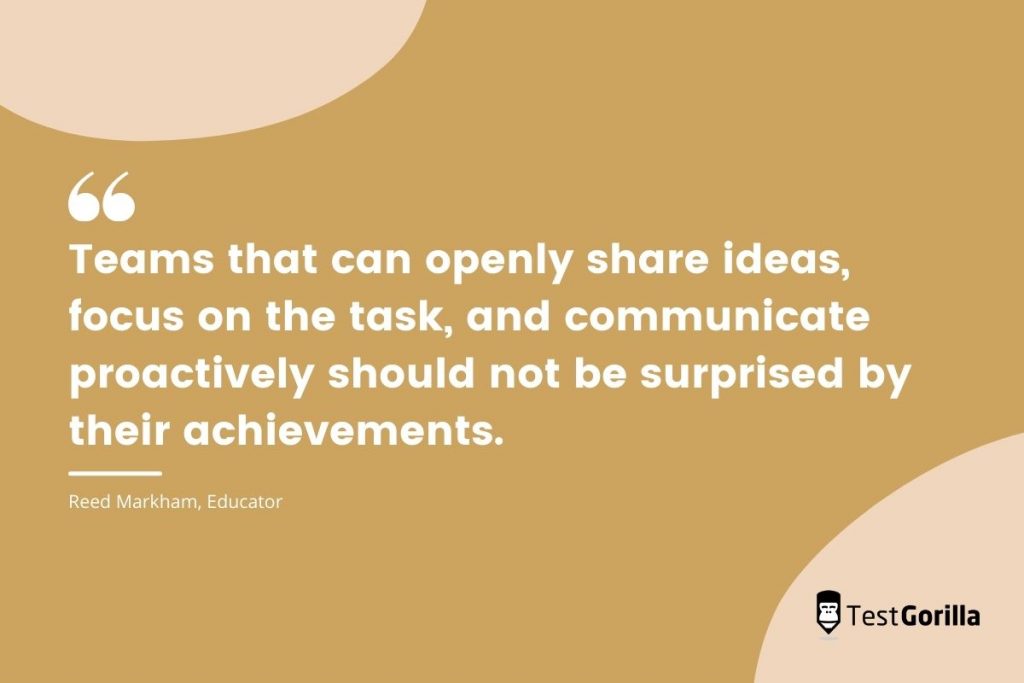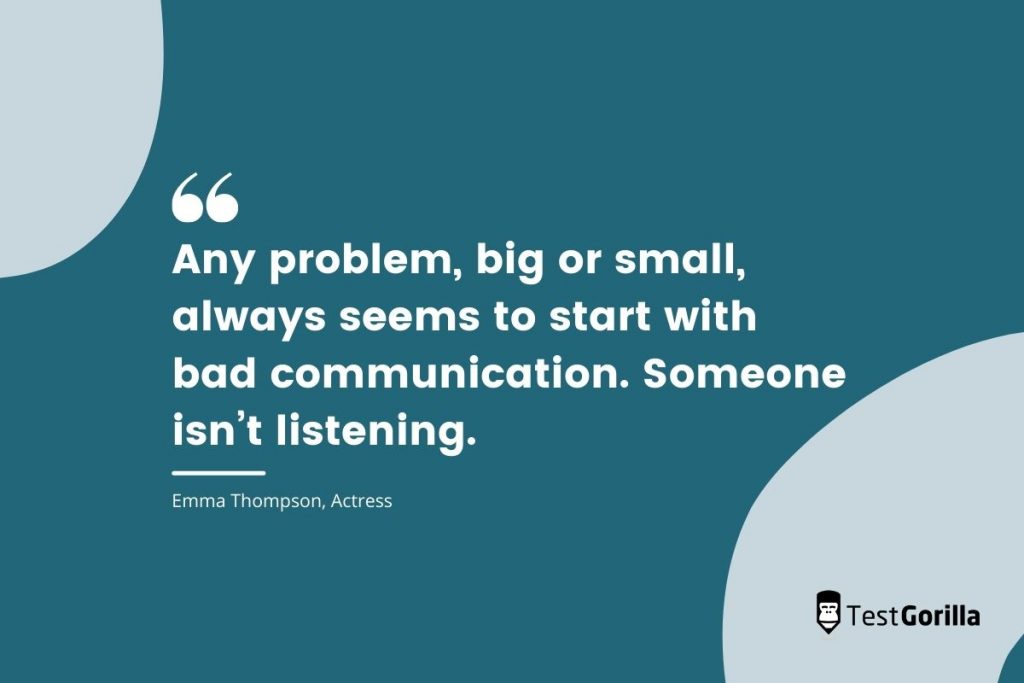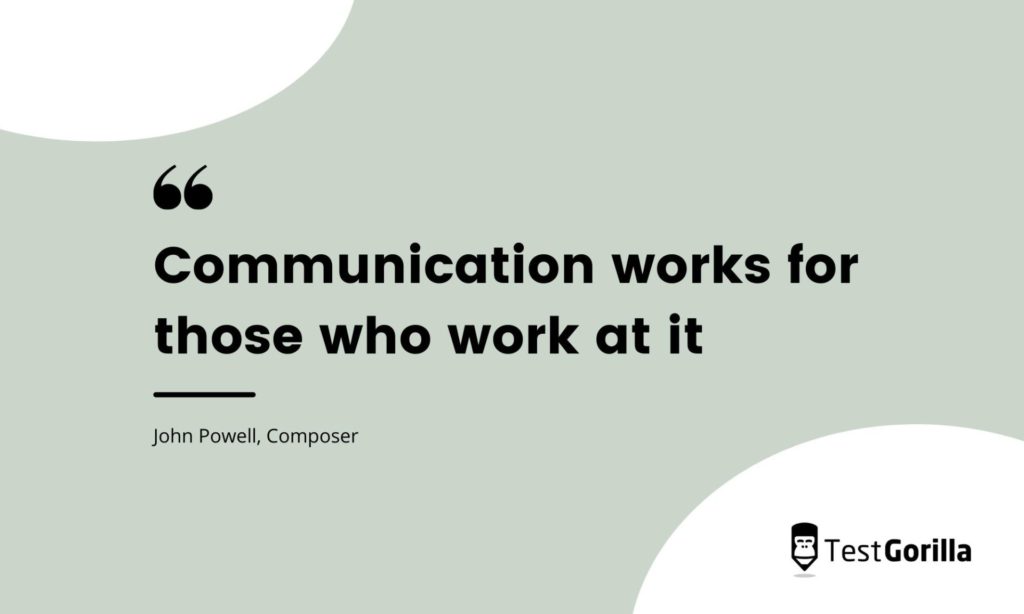Many assume that workplace communication is something that just occurs naturally, but this is an oversimplification that may be the downfall of your team. Strong communication is a key element in ensuring smooth operations within the workplace and it’s something you must actively promote.
This article will highlight some common pitfalls to look out for before addressing key ways that you can improve workplace communication.
Table of contents
Common pitfalls in workplace communication
A thorough understanding of how to best convey and receive messages within your team can improve the efficiency and effectiveness with which your team collaborates. By following best practices in workplace communication, management will be better able to lead and delegate tasks to their team, and colleagues will better understand and support each other.
Unfortunately there are a few obstacles that can get in the way of effective workplace communication.
Preserving rigid hierarchies
One impediment to good workplace communication occurs in more traditional work environments that are structured according to rigid hierarchies. In these companies, communication can be perceived as a unidirectional thing, with information trickling down from managers and leaders down to their subordinates.
This is perceived to be efficient and direct, as employees can receive information as needed, directly from their superiors.
But sticking too rigidly to hierarchical structures may turn out to be a hindrance to your teams. For example, relying on strictly delineated information channels slows down the flow of information, and tends to be less efficient than sending out a mass email or alert via other workplace communication channels, which ensure that all relevant parties receive the information as soon as possible through a centralized channel.
In addition, a hierarchical office culture sometimes prioritizes instructions and information from superiors or managers in a way that may not benefit your company. This method of disseminating information rests on the assumption that your junior employees have little valuable feedback or suggestions to offer when this is rarely the case in modern workplaces.
Consider the diversity of backgrounds and lived experiences across different levels of seniority in the workplace, and it’s clear that each employee, regardless of rank, may have a valuable perspective that differs from management-level employees.
Failing to develop systems of obtaining feedback from your employees may also lead to miscommunication or unresolved differences in opinion that could have been discovered and dealt with earlier.
Sending excessive information
On the other hand, some workplaces suffer from a culture poor top down communication. Employers at the management-level or senior-level staff may be worried that their subordinates lack clarity on the macro-level operations and goals of the company, or that they have insufficient knowledge to move forward with work independently.
In order to resolve this issue, upper-level employees of the company may feel compelled to pre-emptively send multiple highly detailed releases to ensure that all their bases have been covered.
While this does ensure that all relevant information has been transmitted to the necessary parties, pre-emptive attempts to provide the maximum amount of possible information could worsen communication rather than improving it as intended. With a deluge of information coming through channels like email or Slack, employees may find it challenging to sift through everything in order to identify the details that are actually relevant and important to their roles.
When employees need to retrieve information or select details, searching through multiple emails from their superiors—or worse, different communication platforms with scattered pieces of information—creates unnecessary stress for your employees.
This can lead to employees becoming desensitized to the information made available to them. If the vast majority of information employees receive is irrelevant to their responsibilities they will often begin to pay less attention to this information.
This necessarily leads to communication plummeting in efficacy over time, as employees will no longer be willing or able to identify the information relevant to their roles out of the mass of updates constantly pinging their laptops and phones.
Neglecting the needs and preferences of employees
One final mistake to beware of in workplace communication more generally, is neglecting to consider the needs and preferences of your employees regarding standards and expectations for workplace communication. If communication norms and guidelines for your workplace or for your specific team are not discussed and accepted by all members, you run the risk of imposing them unfairly on individuals whose personal preferences may conflict with the status quo.
This might make some employees feel as though you’re encroaching on their boundaries, which can reduce the efficacy of workplace communication.
Some employees may prefer receiving information via official work-dedicated platforms, such as their work email or a dedicated Slack channel. Others may prefer having access to company communications easily via mobile platforms. Some employees may be OK with receiving an after-hours phone call, while others may not.
These divisions arise based on your employees’ priorities, whether this is efficiency, accessibility, or a clearer separation of their work and their personal lives. Since approaches to communication may vary highly within your workplace, it is important to seek your employees’ perspectives early on and establish shared standards that align with the comfort and preferences of the majority.
This way, you can respect everyone’s boundaries and allow them to work in a way that allows them to be productive.
Hiring employees who aren’t good communicators
No surprise here. If you hire employees who aren’t good communicators, workplace communication will suffer. Communication skills are more important for some roles than others, but to ensure that everyone has a basic ability to communicate clearly, effectively, and professionally.
You can do this during the interview process, or use a test like TestGorilla’s communication test to assess candidates in both written and verbal communication, as well as non-verbal cues and active listening.
Improving workplace communication
In addition to avoiding the pitfalls above, their are several things you can do to promote better workplace communication. By being proactive about improving the way employees communicate with each other, you’ll help your company perform at the highest level.
Establish clear guidelines
The first step to optimizing workplace communication is to ensure that everyone is on the same page. As with most workplace norms, this is something that established members of your team may simply take for granted and expect new members to pick up and follow automatically. However, when your team begins a new project with another team or welcomes new members, it can be beneficial to have a brief discussion on communication styles and preferences.
This allows all parties to voice their needs and opinions early on so your team will be able to make the necessary adjustments for maximum performance and comfort from the beginning of the project. This also ensures that expectations are known by all team members, with no unspoken expectations that may cause interpersonal conflict down the line.
Learn team preferences and strengths
Based on the guidelines you set with your team, you can identify which modes of communication work best for everyone.
For example:
Are there platforms your employees seem to prefer using? Don’t dismiss them without doing your research. Technology is advancing at a rapid pace and new tools can have innovative and useful features that will improve the way you do business.
Do your employees prefer remote or digital group meetings or in-person chats? There are times when it’s necessary for everyone to be in the same room together, but, when that’s not the case, you may find that a Zoom meeting is less disruptive for your team.
Do your employees work better with regularly scheduled meetings or with meetings scheduled on a case-by-case basis depending on necessity? Regularly scheduled meetings can help keep everyone on track, but if your team does well working independently, you may find that they can get a lot more done when you only have meetings as needed.
In order to understand your team’s preferences better, you can of course hold meetings to discuss their thoughts on these issues. However, these conversations are not always the most fruitful, as individuals may either not be entirely sure of their own preferences, or they may be hesitant to raise their points if they are in the minority.
While it’s important to take everyone’s point-of-view into consideration, you’ll also have to evaluate whether these preferred modes of communication are a good fit for the work you have to do individually and as a team. For example, if you need to work collaboratively or are on a very tight deadline, digital modes of communication with instant updates may suit your needs better than, for example, waiting for a weekly in-person team meeting.
Remain flexible and take feedback
It is also good practice to recognize that systems of communication should not be too rigid. As your team develops or new communication tools become available, keep an open mind to possible improvements that may enhance your workplace communication.
When seeking input on things to tweak or update regarding team communication, try to be open to taking feedback from all members of your team. Communication strategies at the workplace are most useful when they benefit your team across the board.
In some cases, there may be a vocal minority who feel strongly about particular communication strategies such as texting versus email, or members who want a clear line between their work-life and their home-life. While accommodations can and should be made where possible, the minority should also be encouraged to expand their horizons and adapt to the prevailing majority in an effort for mutual compromise.
A dynamic system of developing and refining communication norms like this requires proper feedback channels that can receive employee opinions regularly. These channels should also be consciously framed as non-threatening to employees, either by allowing anonymous submissions, providing assurances that feedback requesting change will not harm their career or other protections.
The best insights on HR and recruitment, delivered to your inbox.
Biweekly updates. No spam. Unsubscribe any time.
Workplace communication tips for remote workers
Since the beginning of the pandemic in 2020, work arrangements globally have gone through substantial changes. The majority of workplaces were unexpectedly thrust into remote work, and many employees have continued to work remote. This arrangement requires a more thoughtful approach to communication in order to ensure your team functions smoothly despite the distance.
In addition to the other tips provided earlier in the article, here are some specific pieces of advice to keep in mind if some or all of your team is working remotely. (But they’re important for companies where everyone works on-site too!)
Utilize workplace communication technology effectively
In the present era, technology has developed to the point where email is no longer the only option available for remote workers. There are multiple tools that allow for different styles of communication and collaboration, allowing you to choose whichever option best suits your team.
If your office is semi-remote, either with split-team divisions or with some individuals based in different locations, you may benefit more from digital meetings run on Zoom or similar software. Having regularly planned video meetings can offer your team some face time with one another, fostering a greater sense of community and bonding as compared to other text-based mediums.
At TestGorilla, we are a completely distributed team, with employees around the globe. One of the things we do to keep lines of communication open is have a brief weekly meeting that goes something like this.
First, the meeting facilitator for the week asks a fun question that changes every week. For example, “What do you like to do for fun?” or “What’s your favorite 80s movie?”
Then, every week we talk about what accomplishment from last week we’re most proud of.
We also talk about what we plan to do the next week and let the team know if we’ll need any help.
Finally, the meeting facilitator asks a big picture question about how we can improve as a company.
We do our meetings in Google Meet, but there are a lot of other options out there (e.g., Zoom). In addition to meetings, you can consider utilizing planning tools like Trello or Basecamp in order to visualize project timelines and the progress of delegated tasks.
Once employees have been briefed on how the company plans to use these tools, they can become efficient repositories for information on the project at hand. This not only encourages detailed documentation of one’s work and prompt updates in a shared platform but also eliminates the need for unnecessary meetings as all the required information is centralized and widely accessible.
And of course, who could forget about Slack? Having a workplace communication tool that allows for quick questions helps make up for the fact that everyone isn’t in the same building. (Whether you turn on the Giphy integration or not is up to you…)
Hence, remote workers would do well to recognize the innovations in communication and co-working technologies, as these are indispensable if you do not have the opportunity to work together physically full-time.
Create opportunities for social interaction
Within physical workplaces, employees often have the chance to chat with one another and build social bonds within the team over topics outside of their professional roles. This can be extremely beneficial for fostering camaraderie and connection between members of your team, which can help the workplace to feel less sterile.
In the office Slack group, you might consider making dedicated channels for employees to engage in friendly chats about things that aren’t about work like their pets, children, or special interests, simulating the environment of an office pantry or a shared lunch. This way, everyone will begin to view each other as more than co-workers, and you can begin to craft a positive office culture despite the distance between everyone.
Understanding each other’s personal lives a little more may also help with developing empathy and compassion, which are highly beneficial qualities when obstacles crop up in the line of work.
Another way to do this is to have fun, “meetings” that aren’t about work. For example, in addition to the brief meetings above and other miscellaneous work-related meetings we have at TestGorilla, we have a monthly social on Google Meet. Our Head of Content, Dr. Julia Melymbrose has taken on the difficult task of coming up with fun activities for the TestGorilla team to participate in via video chat.
These events make everyone feel more connected and help us develop the sort of camaraderie you’d find in a brick and mortar office.
It’s important to make sure your employees enjoy working for your company if you want them stick around. So it makes sense to create opportunities for them to have some fun together.
Communication is key
By implementing these recommendations and avoiding the obstacles described above, you’ll create a better working environment for everyone in your company. And when everyone is communicating clearly and getting the information they need, they are able to focus all of their energy on the task at hand and complete their job duties more efficiently.
So for the sake of improving workplace relationships, productivity, and morale, consider where you can potentially improve communication in your workplace. You’ll be glad you did!
You've scrolled this far
Why not try TestGorilla for free, and see what happens when you put skills first.
























